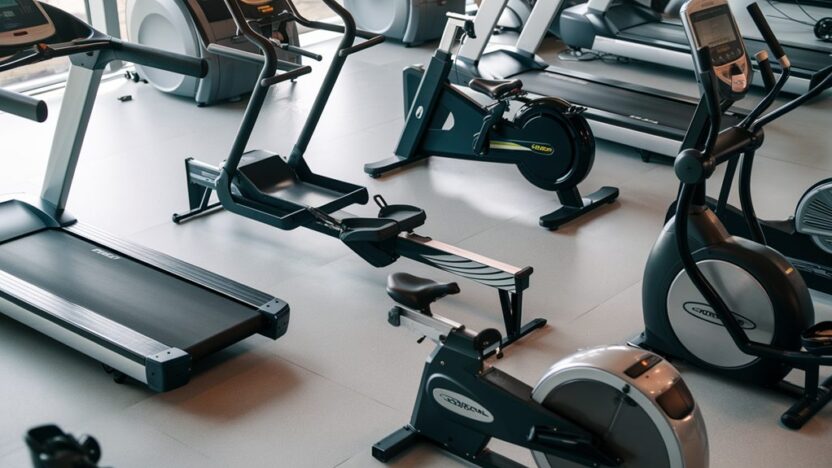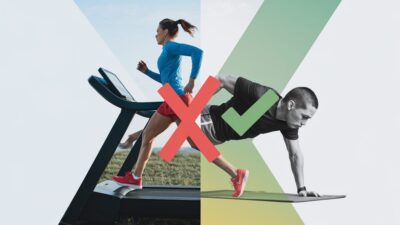When choosing cardio equipment, you'll want to take into account your available space, budget, and fitness goals. Popular options include treadmills ($500-$2,500), ellipticals, stationary bikes ($200-$1,500), and rowing machines, each offering unique benefits for your workout routine. Look for vital features like clear display consoles, ergonomic design, and performance tracking capabilities that match your needs. Safety features and proper form are essential, so make certain you have adequate clearance around equipment and understand correct posture. Start with 20-30 minutes of exercise, gradually increasing duration as your fitness improves. The journey to selecting the perfect cardio equipment leads to even more opportunities for enhancing your fitness journey.
Popular Cardio Equipment Types
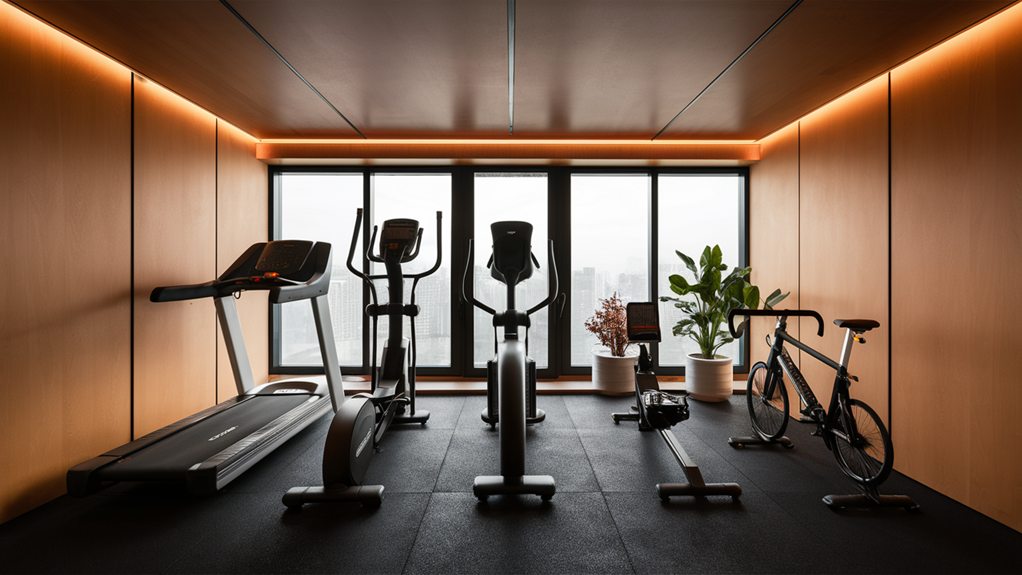
Anyone looking to improve their cardiovascular fitness will find several effective equipment options at most gyms. Engaging in regular cardio exercises can notably enhance your heart health, contributing to improved circulation and a reduced risk of cardiovascular diseases.
When you're choosing the right cardio equipment, you'll want to reflect on your fitness goals, available space, and budget.
Treadmills remain the most popular choice for both gym and home workouts, offering versatile options for walking, jogging, or running at adjustable speeds and inclines. If you're seeking low-impact alternatives, elliptical machines provide smooth, fluid motions that protect your joints while engaging both upper and lower body muscles.
For those interested in cardio machines for home workouts, stationary bikes offer compact solutions that won't take up much space.
When selecting the best cardio equipment for home, you'll also want to reflect on rowing machines, which deliver full-body workouts while improving strength and endurance. Stair climbers and stepmills effectively target your lower body while providing intense cardiovascular benefits.
Each piece of equipment offers unique advantages, so you might want to try different machines at your gym before investing in home equipment, ensuring you'll choose something you'll use consistently and enjoy.
Space and Budget Considerations
Your home's available space and budget play essential roles in choosing the right cardio equipment. Before investing in top cardio machines for fitness, you'll need to measure your designated workout area carefully, including ceiling height for taller equipment like ellipticals. Remember to add about three feet of clearance around each piece for safe, comfortable movement.
Understanding your energy balance and how it relates to your fitness goals can also help you select equipment that meets your needs, particularly when focusing on essential nutrition tips.
When it comes to budget planning, consider both the upfront costs and long-term expenses. While treadmills often range from $500 to $2,500, you can find quality folding models that save space and money.
Stationary bikes typically cost between $200 and $1,500, making them a more budget-friendly option that won't take up much room. For tight spaces, resistance bands and jump ropes offer effective cardio workouts at minimal cost.
Don't forget to factor in maintenance costs, warranty coverage, and potential electricity usage. If you're working with limited space and funds, look for equipment with multiple functions, such as rowing machines that fold up or adjustable step platforms that store easily.
Many retailers offer financing options, seasonal sales, and certified refurbished equipment to help make your purchase more affordable.
Key Features to Compare
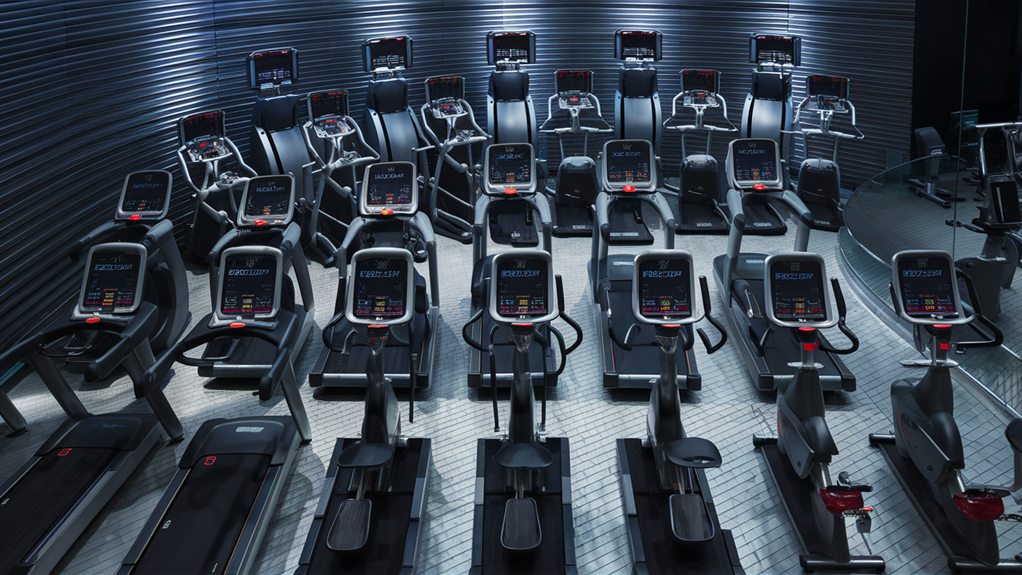
Making an informed decision about cardio equipment requires understanding the specific features that set different machines apart. When you're comparing different options, you'll want to focus on the elements that directly impact your workout experience and long-term satisfaction with the machine.
Modern cardio equipment comes with various technological innovations and comfort features that can make your exercise routine more effective and enjoyable, ultimately contributing to improved heart health and overall fitness boost your health.
- Display Console Features: Look for clear, easy-to-read screens that show essential metrics like heart rate, calories burned, and distance covered, while considering whether you'd benefit from pre-programmed workouts or interactive training programs.
- Ergonomic Design Elements: Check the equipment's adjustability options, including seat positions, handlebar placement, and stride length, ensuring they'll accommodate your body type and movement patterns.
- Performance Tracking Capabilities: Consider connectivity features that let you sync your workout data with fitness apps, plus any built-in performance monitoring tools that help track your progress over time.
Your choice should align with your fitness goals, taking into account how you'll use these features in your regular workout routine.
Safety and Proper Form
Safety measures and proper form serve as the foundation for any effective cardio workout routine. When you're using any piece of cardio equipment, it's crucial to maintain proper posture and alignment to prevent injury and maximize your results. Additionally, incorporating injury prevention techniques can help enhance your safety during workouts.
Before you start your workout, you'll want to familiarize yourself with the emergency stop features on your machine, and always attach safety clips when they're provided. Keep your head up, shoulders back, and core engaged throughout your session, allowing your body to move naturally without forcing any movements. You shouldn't feel any sharp pain or unusual discomfort while exercising.
On a treadmill, you'll need to stay centered and avoid looking down at your feet. When using an elliptical, keep your feet flat on the pedals and maintain an upright position. For stationary bikes, adjust the seat height so your knee has a slight bend at the bottom of each pedal stroke.
With rowing machines, remember to drive with your legs first, then pull with your arms, keeping your back straight throughout the movement. Remember to start slowly and gradually increase your intensity as you become more comfortable with the equipment.
Best Equipment for Home Use
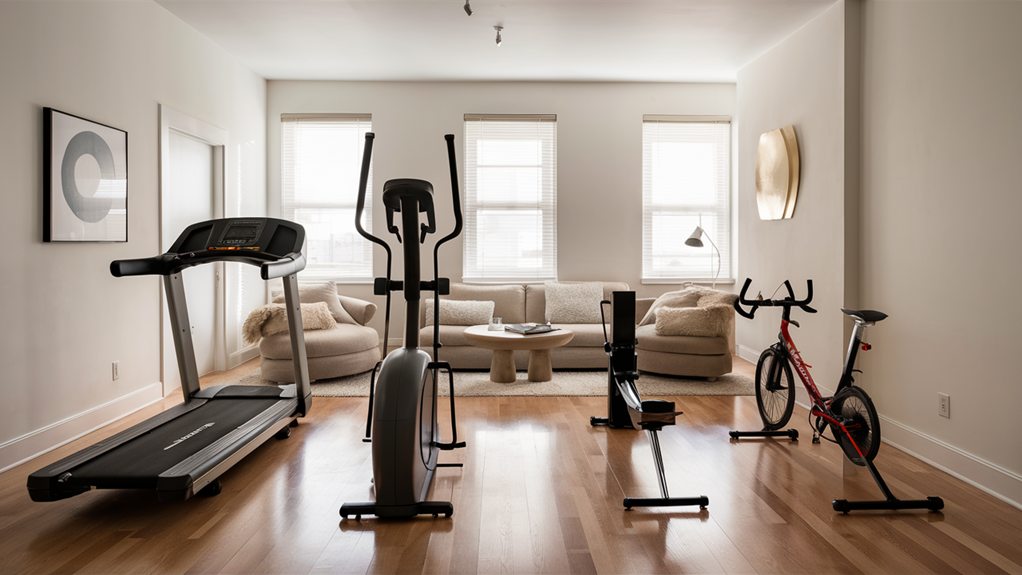
Several excellent cardio equipment options are available for home gyms, with each offering unique benefits for different fitness goals and space constraints.
Incorporating water-based exercises like swimming and water aerobics can also be a great addition to your fitness routine, especially for seniors, as they provide low-impact workouts that enhance mobility.
You'll want to take into account factors like available space, noise levels, and your budget when selecting the perfect piece for your home workout area.
For most home exercisers, these proven options deliver consistent results:
- Folding treadmills: They're perfect for walking or running year-round, and you can store them easily when not in use, making them ideal for smaller spaces.
- Stationary bikes: They're quiet, low-impact, and excellent for all fitness levels, plus they're typically more affordable than other cardio machines.
- Rowing machines: They provide full-body workouts and can stand upright for storage, though you'll need to learn proper form.
When you're setting up your home gym, you'll find that compact, versatile equipment offers the best value.
You don't need to break the bank to get quality gear, as many manufacturers now offer space-saving designs with essential features at reasonable price points.
Take into account starting with one primary piece that matches your fitness goals, and you can always expand your collection as your needs evolve.
Maximizing Your Cardio Workout
To get the most from your cardio equipment, you'll need to focus on three key aspects: intensity, duration, and technique. Recovery is also vital in maximizing your cardio performance, as it allows your body to repair and strengthen itself after workouts, which is essential for endurance athletes.
When you're working out, pay attention to your heart rate, making sure it stays within your target zone for ideal fat burning and cardiovascular benefits. You can easily calculate this zone by subtracting your age from 220 and aiming for 60-80% of that number.
Your workout duration should match your fitness goals, but start with 20-30 minutes if you're new to cardio exercise. As your endurance improves, you can gradually increase your time to 45-60 minutes per session. Remember, consistency matters more than lengthy workouts when you're beginning.
Additionally, incorporating proper nutrition and rest, as emphasized in essential recovery tips, will further enhance your performance.
Proper technique prevents injury and guarantees you're getting the full benefit of your workout. Keep your posture straight, breathe steadily, and maintain a smooth, controlled motion on whatever equipment you're using.
Don't grip handlebars too tightly on treadmills or ellipticals, as this reduces calorie burn and can strain your shoulders. Instead, focus on engaging your core and keeping your movements natural and fluid.
